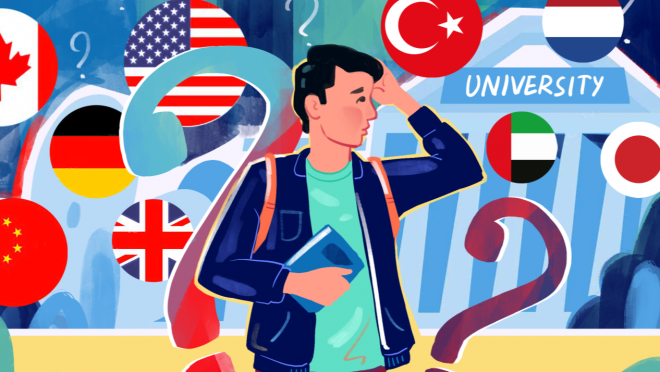From Dhaka to down under: Navigating Australia's student application process
From Dhaka to down under: Navigating Australia's student application process

Australia has long been a popular study destination for students from South Asia—especially for those from Bangladesh. In recent years, that interest has only grown.
Between January and October 2022, over 594,000 international students began their higher education journey in Australia. Among them, the number of Bangladeshi students saw a notable rise—enrollments jumped by 15% during that period.
With so many students now eyeing Australia for their bachelor’s degrees, the application process has naturally become more detailed and competitive. Since top universities offer a wide range of subjects and specialisations, aspiring students need to do their homework before diving into applications.
Subject preferences for Bangladeshi students
For most Bangladeshi students as well as foreign nationals, STEM subjects are still a top priority. About 25% of all foreign students currently enrolled in various universities choose a subject from STEM, and the choice for Bangladeshi nationals is no exception.
An applicant named Samin Yaser, who had recently completed his Higher Secondary Certificate (HSC) from BAF Shaheen College before applying, explains that he too was looking for a degree in STEM.
“I wanted to study something related to my courses in HSC. Having a science background, I found a degree in Information and Technology is quite attractive,” said Samin.
Preparation
Although some universities are leaning towards PTE and other modes of language proficiency testing such as TOEFL, the IELTS exam is still the most prevalent and widely accepted metric for universities to judge the level of English among would-be undergrads.
The standard band score in IELTS still remains 7, however, most universities today are accepting students with 6.5 scores, even in STEM subjects. Samin has prepared and sat for his IELTS exam just after completing his HSC exams, and comfortably received his desired score to apply for university admissions.
Applications process
The application process may seem tedious at first, but all universities have a simple and easy-to-follow application procedure through their respective websites. One can easily follow the guidelines on the websites to complete the process.
The standard documents required for applications, such as mark sheets, certificates, letters of recommendation, and Statement of Purpose (SOPs), as well as the IELTS results, can all be provided online via application forms on the university website, or in some cases, through university emails.
The students must be diligent about what universities and subjects they prefer the most because for every application, a certain amount of fees may be applicable. For Samin’s case, Sydney was the obvious choice because he already had close relations there, so it was a matter of finding the right university and subject.
As soon as he got his IELTS score, he applied to Victoria University, “I got the confirmation letter within 24 hours of applying,” said Samin. Samin did consult an agency, but the process was easy to follow. He wanted a degree relating to his background. Considering the tuition fees and close vicinity to his relatives, he chose Victoria University for Bachelor of Information and Technology.
However, not all institutions are accepting of South Asian students. Students looking for institutions must know that only registered universities or institutes with the Commonwealth Register of Institutions and Courses for Overseas Students (CRICOS) accept students with South Asian backgrounds. While most universities are registered, students should still verify when choosing their preferred university.
Applying for student visa
Once a university accepts a student’s application, it issues a document called the Confirmation of Enrollment (CoE). The visa application form can easily be found on the Department of Home Affairs website. The amount you need to pay for your first semester can vary depending on the university, but you’ll generally need to pay the admission fee along with the first semester’s fees upfront.
For Samin, there were also two additional costs: an embassy fee and the Overseas Student Health Cover (OSHC), which came to around 4,500 Australian dollars after he got his visa.
Another key part of the visa application is proving your financial solvency, which includes showing a certain amount of money in your bank account. “I had to show 50 lakh BDT, which had to remain in my account until I landed in Australia. Thankfully, my visa didn’t require any extra fees,” said Samin.
When asked if he received any help along the way, Samin shared, “The agency helped me file the applications, but everything else—choosing the university and getting the confirmation letter—I did all by myself online.”
Overall, Samin found the entire application process to be smooth and straightforward.
With Australian universities offering a range of desirable degrees and lower IELTS score requirements, it’s no wonder they are such an attractive option for Bangladeshi students.
Work prospects
For students, during the ongoing semester, no more than 20 hours per week is permitted, and Australia has a minimum wage starting from 20 AUD/hour, which can also increase depending on the cities or type of work the student might engage in.
During the semester break, any student can work as a full-time employee with all the benefits and compensation of a standard Australian worker. Therefore, gaining experience and the opportunity to immerse oneself in the cultural landscape is easier.
Post graduation
Graduating with solid job prospects can open up the opportunity for a post-study work visa, allowing you to stay in Australia and gain valuable experience.
Once you graduate, you can apply for a Temporary Graduate Visa, which can last up to four years, depending on the type of work you secure. Jobs in fields like STEM can be particularly helpful, as employers can vouch for your skills, making it easier to explore long-term settlement options.
Australia’s points-based immigration system takes into account your education, work history, and other qualifications. So, with a degree and some work experience under your belt, you might be eligible to apply for skilled migration and eventually work towards permanent residency.


